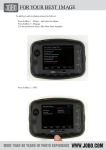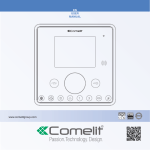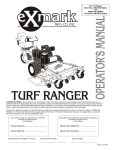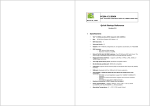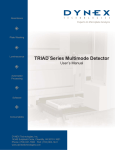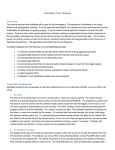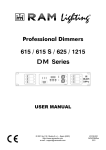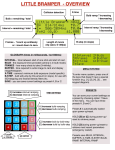Download User`s Manual for latest Camera Firmware
Transcript
(26'6HULHV'LJLWDO&DPHUDV 1HZ)HDWXUHVDQG8VHU·V*XLGH8SGDWHV This is an update to the EOS D Series User’s Manual. It contains the following information: ✔ New features available on EOS D Series cameras with firmware version 3.0 or later ✔ Updates to the Quick Setup Guide and User’s Manual Table of Contents Contents 1 New Features .................................................................. 1 New Look for the Image Display................................................................ 2 Menu Bar ............................................................................................ 2 Navigation Techniques ....................................................................... 4 Status Bar ........................................................................................... 6 Dual Slots for PC Cards.............................................................................. 7 Selecting a PC Card or Folder ............................................................ 8 Deleting Images .................................................................................. 9 Formatting a PC Card ....................................................................... 10 JPEG File Processing ................................................................................ 11 Processing with Two PC Cards ........................................................ 11 Processing Images ............................................................................ 12 Changing Processing Settings .......................................................... 15 Working with TIFF Custom Files on your Computer ...................... 17 White Balance ........................................................................................... 18 Selecting Custom White Balance ..................................................... 19 White Balance Settings .................................................................... 19 Intervalometer ........................................................................................... 24 Recovering Deleted Images ...................................................................... 26 Name Plate ................................................................................................ 27 Global Positioning System........................................................................ 28 IPTC Data Management ........................................................................... 30 Loading IPTC Data from a PC Card .................................................31 Sharpening ................................................................................................. 32 On the Camera ...................................................................................33 In the DCS Acquire Module or DCS TWAIN Data Source .............34 Quick Setup Guide and User’s Manual Updates .......... 37 Quick Setup Guide Updates (EOS D2000 and D6000) ............................. 37 User’s Manual Updates.............................................................................. 37 EOS D2000 .......................................................................................37 EOS D6000 .......................................................................................38 EOS D2000 and D6000 .....................................................................38 New Features 2 EOS D Series cameras (firmware version 3.0 or later) provide the following new features: ✔ A new look for the Image Display ✔ Dual active slots for PC Cards ✔ Enhanced White Balance functionality ✔ An Intervalometer that allows you to set your camera to capture a series of images automatically ✔ The ability to recover deleted images ✔ A name plate that you can personalize ✔ A Global Positioning System option that determines the exact latitude and longitude of the camera ✔ IPTC data in image header 1 New Features ✔ JPEG file processing that allows you to finish files on the camera (EOS D 2000 only) New Look for the Image Display The Image Display has been redesigned to be easier to use and to provide more space for menu choices and image-related information. There is a new way of using the Menu bar, and a new Status bar that appears in Image Review mode. Menu Bar To provide more room on the Image Display screens, the Menu bar is only displayed at your request. When you turn the Image Display On, the last screen used appears without the Menu bar. If you then press the DISP/MENU button, the Menu bar appears. ☛ Shortcut, press and hold the DISP/MENU button to turn the Image Display On and display the Menu bar. The original Menu bar looked like this: The new one looks like this: Icons for the most frequently used functions are arranged at the left of the Menu bar. The Contrast icon appears at the right. When the Menu bar is displayed, the contrast of the remainder of the screen is lowered, giving it a “grayed-out” appearance. 2 When you select an icon at the left of the Menu bar, the following dropdown menus appear: Icon Folder icon Dropdown Menu One PC Card: Function Displays the Folder menu. (Refer to Chapter 4 of the User’s Manual.) New Features Two PC Cards (page 7): Menu icon Displays choices for the Main, Properties, and Custom Functions menus. Display icon Displays choices for Single, Four, and Nine Image Review mode. (Refer to Chapter 10 of the User’s Manual.) ☛ When you select the Contrast icon (at the right of the Menu bar) you adjust the display contrast as described in Chapter 10 of the User’s Manual. The only difference is that the slider bar now appears at the top of the screen. 3 Navigation Techniques Use the following guidelines when navigating the Image Display Display the Menu bar and select a Menu bar icon Press and hold the DISP/MENU button and rotate the Quick Control dial until the desired icon is highlighted. Display a Dropdown menu Highlight the Folder, Menu, or Display icon, and continue pressing the DISP/MENU button until the dropdown menu appears. 4 Choose an item from a dropdown menu When a dropdown menu appears, continue to press the DISP/MENU button and rotate the Quick Control dial until the desired menu choice is highlighted. Press and hold the SELECT button and rotate the Quick Control dial to highlight your choice. 5 New Features Chose an item from a menu screen Setting the Dropdown Menu Lag Time The default delay between the time a Menu bar icon is highlighted and its dropdown menu appears is 750 milliseconds. You can change this time using the Properties menu. 1 Select the Menu icon then choose Properties from the dropdown menu (page 4). The Properties menu appears. 2 Choose Dropdown Menu Lag from the Properties menu. The Dropdown Menu Lag screen appears. 3 Choose a number from 1 to 5. 1 gives the longest delay, and 5 gives the shortest. (A setting of 3 provides a 750 millisecond delay.) Status Bar A Status bar appears whenever images are displayed (Single, Four, or Nine Image Review mode). Information about the currently selected image appears on the Status bar: ✔ The currently active PC Card (if there are two cards in the camera) ✔ The currently active folder Two PC Cards ✔ Sound icon (if one or more sound files are associated with the selected image) ✔ Tag icon (if the selected image has been tagged) One PC Card ☛ Refer to Chapter 10 of the User’s Manual for information on tagging or associating a sound file with an image. 6 Dual Slots for PC Cards The second PC Card slot has been enabled on the EOS D Series camera. With Type II PC Cards, you can use one or both slots. With Type III PC Cards, only one slot can be used. The card in the bottom slot is referred to as CARD0, and the card in the top slot as CARD1. You insert PC Cards as described in Chapter 4 of the User’s Manual. With one card, you can use either slot. With two cards, the first card inserted will be the active card. When you capture or delete images they will be saved to or deleted from the active card. With two PC Cards, the following procedures are slightly different than those described in the User’s Manual. (With one card, refer to chapter 4 of the User’s Manual.) ✔ Selecting a PC Card or folder (page 8) ✔ Deleting images (page 9) ✔ Formatting a PC Card (page 10) IMPORTANT: Your camera uses 3 volt or 5 volt PC Cards. When you use two cards, they must both have the same voltage. If you insert two cards with different voltages, neither is powered. A “Card Voltage Mix” message will appear. You would need to remove one of the cards so that the other can be powered. 7 New Features CARD1 CARD0 Selecting a PC Card or Folder 1 Select the Folder icon (page 4). If there is no PC card in the camera, an X appears within the Folder icon. Selecting the icon produces this screen: With one PC Card, this dropdown menu appears with a • displayed next to the currently active folder. With two PC Cards, this dropdown menu appears with a • displayed next to the currently active card and the currently active folder on that card. A 0 or 1 appears in the Folder icon, indicating the active PC Card. The listed folders are on the active card. The folder list changes when you change cards. The numbers in parentheses next to the cards and folders indicate the number of images in each. 2 Continue pressing the DISP/MENU button. 3 With two PC Cards, select CARD0 or CARD1 from the dropdown menu (page 5), then select a folder. With one card, select a folder. 8 Deleting Images With one card inserted, you display the Main menu (page 4), then delete images as described in Chapter 10 of the User’s Manual. With two cards inserted, do the following: 1 Select a different PC Card, if necessary (page 8). 2 Select the Menu icon, then choose Main Menu from the dropdown menu (page 4). 3 Select Delete Images. The Delete Images screen appears, displaying choices for the active PC Card. 4 Press and hold the SELECT button and rotate the Quick Control dial to highlight your choice. 9 New Features The Main menu appears. Formatting a PC Card With two cards in the camera, you must first remove the inactive card to avoid formatting the wrong one. You may then format the card using either the Quick or the Full format. IMPORTANT: Quick format, while faster, is not recommended if there is a possibility that the data on the card is corrupted. 1 Select the Menu icon, then choose Main Menu (page 4). 2 Select Card from the Main menu. The Card menu appears. 3 Choose Quick Format or Full Format. If two cards are in the camera, you will be prompted to remove the inactive card. For example, if CARD0 is active, you will be prompted to remove CARD1. 4 Remove the inactive card, then select Retry. If you remove the active card, this message appears: 5 Re-insert the card in the proper slot, then select Retry. 6 Proceed with formatting as described in Chapter 4 of the User’s Manual. 10 JPEG File Processing The EOS D2000 camera supports background image processing which produces JPEG or TIFF RGB files that can be opened directly by any image editing software. This feature is not currently available on the EOS D6000 camera. The choices for processed files are JPEG Good, Better, Best, and TIFF RGB. TIFF RGB files are not compressed. JPEG Good files have the most compression, JPEG Best have the least—the less compression applied, the better the image quality and the larger the file size. The file size varies, depending on content. JPEG files are saved to a JPEG folder and TIFF RGB files are saved to a TIFF RGB folder. These folders are created on the PC Card when you turn Processing On (if they aren’t already there). If you select the JPEG or TIFF RGB folder for the purpose of reviewing images, then capture an image, a message informs you that images cannot be saved there. The images are saved in the default folder established in Properties. (Refer to Chapter 5 of the User’s Manual.) You can specify whether the original TIFF file is saved or deleted once the JPEG file is saved. You can also specify that only tagged images, or images in a particular folder are processed (page 12). The default for Processing is Off. When you turn Processing On, it stays on until you turn it Off, or remove the PC Card. Processing with Two PC Cards When you have PC Cards in both slots (page 7), images will be processed on the card that is active when you turn Processing On. Processing is not enabled on two cards. If you make the other card active, processing will continue on the card originally designated for processing. For example, if CARD0 is active when you turn Processing On, then you change to CARD1, processing continues on CARD0, but not on CARD1. In this case, if you want to switch Processing to CARD1, you must turn Processing Off, then turn it back On. When turned On, Processing will automatically be set for the active card (CARD1). 11 New Features When you capture images, they are written to the selected folder on the PC Card using the TIFF Custom format, regardless of whether Processing is turned On. If you turn Processing On, JPEG Best, Better, Good, or TIFF RGB files are created in the background (when the camera is not busy with other tasks such as capturing images). Processing Images 1 Select the Menu icon, then choose Main Menu from the dropdown menu (page 4). 2 Select Processing from the Main menu. The Processing screen appears. If two PC Cards are inserted, the active card is indicated (for example, All on CARD1). 3 Press and hold the SELECT button and rotate the Quick Control dial to select your choice. Choice Result OFF Turns Processing Off Tagged Images Processes all tagged images on the active card All in Folder Processes all images in the selected folder on the active card All on Card Processes all images on the active card Change Settings Displays a screen where you can change Processing settings (page 15) The Processing confirmation screen appears. 4 Select OK to begin processing or Cancel to return to the Main Menu without processing. 12 When you enable Processing, certain conditions may exist which will cause other screens to appear, as shown in the table below. Condition Screen Your Action There is no PC Card in the camera. If you click OK, new images will be processed when you capture them to that folder. Similar screens appear when the same condition exists for tagged images or for all images on the card. If processing is enabled for tagged images or all images on the card, then images will be processed as you tag or capture them. Processing is enabled for the selected folder and all images in the folder have been processed. Similar screens appear when the same condition exists for tagged images or for all images on the card. If you click Cancel, Processing is not started. There are two PC Cards in the camera. With processing enabled for one card, you make the other card active, then access the Processing menu. If you click OK, processing continues on the inactive card. If you click Cancel, processing stops on the inactive card. You could then enable processing on the active card. 13 New Features Processing is enabled for the selected folder and there are no images in the folder. Condition Screen Your processing settings are set to delete the original TIFF image (page 15) when you process files. Your Action If you click OK, a second confirmation screen appears. If you click Cancel, Processing is not started. The Processing menu appears. The active PC Card becomes full as images are being processed. This can occur regardless of whether there are one or two cards in the camera. You remove a PC Card at any time while Processing is enabled (whether or not images are currently being processed). 14 Changing Processing Settings There are several processing settings that you can change. The settings are applied to images as they are processed. 1 Select Change Settings (page 12). The Processing Settings screen appears with the current values shown in parentheses. The following screens appear, depending on your choice: Processing Settings Original TIFF File Type Defaults Underlined Screen Result Save Saves the TIFF image (default) Delete Deletes the TIFF image after the processed JPEG file has been saved JPEG Best, Better, Good, TIFF RGB Files are processed to the selected JPEG quality 15 New Features 2 Select the desired setting. Processing Settings Resolution Noise Reduction Look Sharpening Level Defaults Underlined Screen Result 100% Maintains the size and spatial resolution of the original image 67% The size and spatial resolution are reduced to two thirds of the original image size 50% The size and spatial resolution are reduced to one half of the original image size Yes Noise is reduced in processed images No Noise is not reduced. Portrait Applies a lower contrast tone scale with more detail in the highlights and shadows Product Applies a higher contrast, more vibrant tone scale None No sharpening is applied to the finished image High Progressively less sharpening is applied to the finished image Medium Low 16 Working with TIFF Custom Files on your Computer If you don’t process images on your camera, you will need to use one of the following software applications to work with the TIFF Custom files. File Format Module (New product) ✔ This software application allows you to open high resolution TIFF Custom images directly into Photoshop. DCS Acquire Module or DCS TWAIN Data Source If the DCS Host Software CD (included with your camera) includes the DCS Acquire Module and DCS TWAIN Data Source version 5.8 or later, you will be given the option of installing the File Format Module. If the CD includes a version prior to 5.8, the DCS File Format Module will not be included. The DCS Acquire Module or DCS TWAIN Data Source allow you to make enhancements specific to images from your camera, and generally provide the best image quality. When such enhancements are not necessary, the DCS File Format Module provides a fast way to open images in Photoshop where you can perform other enhancements, if needed. ☛ If you attempt to open TIFF Custom files in Photoshop without using the DCS File Format Module, the DCS Acquire Module, or DCS TWAIN Data Source, only the thumbnail version will be available, yielding a less than optimal image resolution. 17 New Features ✔ These are full-featured image editing and acquire software applications. White Balance The EOS D Series camera offers expanded Custom White Balance functionality. You can now save White Balance settings using the DCS Acquire Module or DCS TWAIN Data Source (version 5.8 or later), then load the settings into the camera where you can select and reuse them. You can also delete White Balance settings when they are no longer needed. This feature can save you time if you repetitively work under the same lighting conditions. For example, if you frequently work in an indoor stadium with a particular type of lighting, you can name and save a White Balance setting for reuse. Do the following to save and reuse White Balance settings: 1 Using a gray card, capture an appropriate image. 2 Using the DCS Acquire Module or DCS TWAIN Data Source, save the White Balance setting to a PC Card. (Refer to the KODAK PROFESSIONAL DCS Host Software User’s Manual.) ☛ When you save a White Balance setting to a PC Card, a “.wb” extension is added to the file name. For example, if you save the setting from a file named A0601385.TIF, the setting will be named A0601385.wb on the PC Card. 3 On your camera, select Custom White Balance (page 19). 4 Load the White Balance setting from the PC Card to your camera (page 22). 5 Select the desired Custom White Balance setting (page 21). ☛ You can also delete White Balance settings from your camera (page 21). Selecting Custom White Balance You must select Custom White Balance before selecting, deleting, or loading Custom White Balance settings. Press and hold the W.BAL button and rotate the Quick Control dial until no White Balance icons appear in the Back LCD panel. White Balance Settings Once you have selected Custom White Balance, you can access several Custom White Balance functions. 1 Press the W.BAL button. If the Image Display was Off, it turns On. If there are no images in the folder, the screen at the left appears. 19 New Features When no icons appear, Custom White Balance is selected. If the selected folder contains images, this screen appears, showing the currently selected image. 2 Press and hold the SELECT button and rotate the Quick Control dial to select your choice: OK—The White Balance values from the selected image are saved using the same name as the image. The setting is applied to subsequent images that you capture. (This setting overwrites the setting that was saved the last time you chose OK.) Cancel—The White Balance setting does not change. Options—The White Balance Settings menu appears. You can: ✔ Select a White Balance setting from those loaded on the camera (page 21) ✔ Delete a White Balance setting from the camera (page 21) ✔ Load a White Balance setting from a PC Card to the camera (page 22) 20 Selecting White Balance Settings With the White Balance Settings menu displayed (page 19), choose one of the following: Image #nnnn: The White Balance values from the selected image are applied to images that you capture. Previously loaded setting—The White Balance values from the previously loaded setting (page 22) are applied to images that you capture. Deleting White Balance Settings 1 With the White Balance Settings screen displayed (page 19), choose Delete WB Settings. The Delete White Balance Setting menu appears. 2 Press and hold the SELECT button and rotate the Quick Control dial to choose the setting to be deleted. 3 Release the SELECT button. A confirmation screen appears. 4 Select Yes to delete the setting or No to leave it intact. 21 New Features You can delete White Balance Settings that have previously been loaded on your camera. Loading White Balance Settings Once you have saved White Balance settings to a PC Card, you can load them into your camera. There are a few rules to remember when you do so. If you should forget any of the rules, an appropriate error message appears, as shown in the table below. Rule Error Message You can only load settings into the camera that was originally used to capture the images. Each setting that you load must have a unique name. Your camera will hold up to ten Custom White Balance settings. 22 1 With the White Balance Setting screen displayed (page 19), choose Load from Card. The Load White Balance Setting screen appears with a list of the White Balance settings on the active PC Card. (If only one card is in the camera, the card choices do not appear.) button and rotate the Quick Control dial to choose the desired card. (You may need to scroll up to the card choices if there are numerous White Balance settings.) 3 Repeat step 2 to choose the desired Custom White Balance setting. The setting is loaded from the PC Card to your camera, and subsequently appears in the list of settings. ☛ When you load settings from a PC Card, the last setting loaded is the active White Balance setting. 23 New Features 2 Press and hold the SELECT Intervalometer Your camera has an Intervalometer which you can set so that a sequence of images are captured automatically at specified intervals over a specified period of time. You might, for example, use the Intervalometer to capture the different stages of a flower bud opening. You can set the following: ✔ Number of frames to be captured ✔ Interval between exposures ✔ Delay before the timer begins ✔ Enable or disable the Intervalometer The Intervalometer is disabled automatically after the specified time has elapsed, even if the specified number of images have not been captured. For example, if you set the Intervalometer for fifteen exposures at one second intervals, the camera would only capture images until the buffer is full. The feature would be disabled, even though fifteen images had not been captured. ☛ While the Intervalometer is enabled, the camera will not enter PowerSave mode. 1 Select the Menu icon then choose Main Menu (page 4). The Main menu appears. 2 Choose Intervalometer from the Main menu. The Intervalometer screen appears. 3 Press and hold the SELECT button and rotate the Quick Control dial to choose the desired setting. 24 Your choices in the Intervalometer screen cause the following screens to appear: Intervalometer Settings Screen Your Action Timer Count Set the timer count—1-9999 frames Result Specifies the number of frames to be captured Default: 10 frames Specifies the Set the timer interval—1 second interval between image captures to 23:59:59 (HH:MM:SS) Default: 10 seconds Timer Delay Set the timer delay—1 second to 23:59:59 (HH:MM:SS) Specifies the delay before onset of the Intervalometer function Default: 1 second Timer Enable Select Yes Enables the Intervalometer function Select No Disables the Intervalometer function Default: No ☛ To change settings in these screens, use the same technique described for setting Display Off Time. Refer to Chapter 5 of the User’s Manual. 25 New Features Timer Interval Recovering Deleted Images You can now recover images that were previously deleted from a PC Card, as long as they have not been overwritten. Only images that were written to a PC Card by an EOS D Series camera can be recovered. 1 Select the Menu icon then choose Main Menu (page 4). 2 Choose Card from the Main menu. The Card menu appears. 3 Choose Recover Card. This screen appears. (A Recover folder is created on the PC Card when you recover images.) ☛ You cannot capture images to the Recover folder. If the Recover folder is selected when you capture an image, the image will be saved to the default folder (set in Properties). This screen appears while images are being recovered. When the recovery process is complete, this screen appears, telling you how many files were recovered. 26 Name Plate Using the DCS Acquire Module or DCS TWAIN Data Source, you can enter text that will appear in certain screens on your camera. The Name Plate is useful for personalizing your camera, for example, “This camera belongs to Joe Smith”. In the DCS Acquire Module or DCS TWAIN Data Source: 1 Click the Camera Properties button. The Camera Control dialog box appears. The text that you entered appears in the following screens on the camera’s Image Display: No images in folder n No images in memory No card in camera 27 New Features 2 Enter up to 50 characters of text in the Name Plate text box. Global Positioning System Your camera has an option for a Global Positioning System (GPS) which uses satellite information to determine the latitude and longitude location of the camera. This information, along with the time and date, is saved with the image. You can view it using the DCS Acquire Module or DCS TWAIN Data Source. 1 Insert a Trimble Pathfinder Type II GPS PC Card in slot 1. 2 Select CARD1 (page 8). The card must go in slot 1. If you insert it in slot 0, this message appears. (Insert the card in slot 1 and select Retry.) 3 Select the Menu icon then choose Main Menu from the dropdown menu (page 4). The Main menu appears. When the Trimble Pathfinder card is properly inserted, a GPS choice appears on the menu. 4 Select GPS (page 5). This screen appears during the GPS acquisition process. The process may require up to 1.5 minutes. 28 When the acquisition process is complete, a screen like this appears. If the GPS status is Good Position, the location has been determined and will be saved with images that you capture. The table below lists messages that may appear during the acquisition process: Cause Remedy Unknown. There is an undetermined problem with the GPS card. Insert a different GPS card, reinsert the card or try again later. PDOP too high. The GPS measure of error (PDOP) is too high. Insert a different GPS card, reinsert the card or try again later. No GPS Time. The GPS is not receiving any signal from any satellite. Try again later. No satellites. There is not a viable signal from Try again later. any satellite. 1, 2, or 3 satellites. The GPS requires a constellation Try again later. of 4 satellites. The satellite constellation is not complete. ☛ If any of these conditions persist for more than 1 1/2 minutes, the satellites are blocked by an object such as a tree or a building. Change your location and try again 29 New Features Status Message IPTC Data Management This feature allows inclusion of International Press Telecommunication Council (IPTC) data as part of the image header. You enter the IPTC data on your computer using the DCS Acquire Module or DCS TWAIN Data Source (version 5.8 or later) and save it to a PC Card. (Refer to the KODAK PROFESSIONAL DCS Host Software User’s Manual.) Once the data has been saved to a PC Card, you can load it into your camera (page 31). 1 Select the Menu icon then choose IPTC Data from the dropdown menu (page 4). The IPTC Data menu appears. Press and hold the SELECT button and rotate the Quick Control dial to select your choice: None—No IPTC data will be written to the image headers. IPTC Data File—If there is an IPTC file on the camera, it is displayed. Choosing this option writes the IPTC data to the image header. Load from Card—You can load an IPTC file from a PC Card (page 31). 30 Loading IPTC Data from a PC Card 1 With the Load IPTC Data screen displayed (page 30), choose Load from Card. 2 Press and hold the SELECT button and rotate the Quick Control dial to choose the desired card. (You may need to scroll up to the card choices if there are numerous IPTC files.) 3 Repeat step 2 to choose an IPTC file. The file is loaded from the PC Card to your camera, and subsequently appears in the list of IPTC data files. Each setting that you load must have a unique name. If you attempt to load a file with the same name as one on your camera, a message will ask if you want to place the existing file. 31 New Features The Load IPTC Data screen appears with a list of the IPTC files on the active PC Card. (If only one card is in the camera, the card choices do not appear.) Sharpening Your camera is equipped with an antialiasing filter, an optical filter that is mounted inside the camera in front of the electronic imager. This filter improves overall image quality at the expense of a small loss of sharpness in the image. Depending on your subject, you may or may not want to add sharpening. For example, you might want to sharpen an image of a piece of equipment, and might not want to sharpen a portrait. There might also be instances where you would want to remove the antialiasing filter. When you use the DCS Acquire Module or DCS TWAIN Data Source with your EOS D Series camera, you can specify whether or not you want the image sharpened. The antialiasing filter uses optical design to reduce or eliminate the high frequency image patterning problems associated with single-shot digital capture and interpolation. The optical effect causes a small change in how lenses perform compared to cameras without the filter installed. If you choose to use manual focus, be advised that some zoom lenses experience a shift in the focus point as the focal length of the zoom is changed. If you zoom into your subject matter for close focus, and then zoom out to compose your image, the focus point changes. This is easily remedied by only focusing at the zoom setting that you use to capture the image. 32 On the Camera ☛ This feature is available for the EOS D6000 camera. It is not currently available for the EOS D2000 camera. You can set a camera property which will tell the DCS Acquire Module or DCS TWAIN Data Source whether the antialiasing filter is installed or removed. The default setting is “Installed”. If you remove the antialiasing filter, you will need to set the property to ”Removed”. Refer to Chapter 12 of the User’s Manual for instructions on installing and removing the antialiasing filter. Main menu. Refer to Chapter 5 of the User’s Manual for instructions. The Properties menu appears. 2 Chose Antialiasing Filter from the Properties menu. The Antialiasing Filter screen appears. 3 Choose either Installed or Removed, depending on whether the antialiasing filter is currently installed. 33 New Features 1 Choose Properties from the In the DCS Acquire Module or DCS TWAIN Data Source You can set a preference in the DCS Acquire Module or DCS TWAIN Data Source which will determine whether the sharpening feature is applied to images acquired from your EOS D Series camera. The choices for this preference are: ✔ At Capture (default setting)—Images are sharpened if the camera’s Antialiasing Filter property is set to Installed. ✔ On—Images are always sharpened. ✔ Off—Images are never sharpened. 1 Start the DCS Acquire Module or DCS TWAIN Data Source. Refer to the Readme or the KODAK PROFESSIONAL DCS Host Software User’s Manual for instructions. 2 Click the Preferences Icon. The Preferences dialog box appears. 3 Choose At Capture, On, or Off from the Sharpen Images list box. 4 Choose High, Medium, or Low from the Level list box—(the higher the level, the more Sharpening). 34 The following table shows whether Sharpening is turned On or Off, depending on settings in the camera’s Antialiasing Filter property, and the software’s Sharpen Images preference: Camera Properties: Antialiasing Filter DCS Acquire Module or DCS TWAIN Data Source Preferences: Sharpen Images At Capture On Off Installed On On Off Removed Off On Off New Features 35 Quick Setup Guide and User’s Manual Updates 3 This section provides updates to the existing Quick Setup Guide and User’s Manual. Some of these updates apply to the EOS D2000, some to the EOS D6000, and some to both. Quick Setup Guide Updates (EOS D2000 and D6000) Page Number Change 7 (AC Adapter section): Universal plugs are replaced by six sets of cords, to cover five international plug configurations (one each for US/Canada, UK, Europe, and Australia, and two for Japan). User’s Manual Updates EOS D2000 System Requirements for Your Computer Macintosh ✔ 32 MB minimum RAM (64 MB RAM recommended) available for Photoshop Windows ✔ 32 MB minimum RAM (64 MB RAM recommended) 37 Updates 1-3 EOS D6000 1-3 System Requirements for Your Computer Macintosh ✔ 64 MB minimum RAM (128MB RAM recommended) available for Photoshop Windows ✔ 64 MB minimum RAM (128 MB RAM recommended) Chapter 5 There is a new Antialiasing Filter property available on the EOS D6000. This property is described on page 33 of this document, as part of the Sharpening feature. EOS D2000 and D6000 1-3 System Requirements for Your Computer Macintosh ✔ Macintosh OS 8.1 (or later) system software with Power PC Processor, minimum100 MHz ✔ 100 MB minimum (200 MB recommended) free hard disk space Windows ✔ Windows 95, Windows 98 and Windows NT 4.0 system software with Pentium Processor, minimum 100 MHz ✔ 100 MB minimum (200 MB recommended) free hard disk space 38 Page Number 1-2 Change Two sets of universal power cords (five in each set) so that you can use the AC adapter and the battery charger at the same time is changed to: Six sets of cords, to cover five international plug configurations (one each for US/Canada, UK, Europe, and Australia, and two for Japan). 2-11 Using the Quick Control Dial The following note should appear: ☛ The Quick Control dial is disabled for a short period of time after each exposure. If you change a camera setting with the dial immediately after capturing an image, check that the camera responded appropriately. 3-7 Battery Charger Charging Temperature Range: 10°C to 40°C (10°C to 35°C recommended) Storage Temperature Range: -23°C to 65.5°C (-25°C to 65°C recommended) Depth-of-Field AE [DEP] The following note should appear: ☛ Be careful when using DEP AE mode while your camera is tethered to a computer. It is recommended that you set point 1 and point 2 by manually pressing the Shutter button halfway after aiming at these points. Do not use the computer control to press the Shutter button in this situation. 39 Updates 7-18 Page Number 7-39 Change Change this paragraph: When AEB is used in conjunction with the self-timer, three frames are automatically exposed in sequence after a 2- or 10-second delay. To this: To capture the three frames, you must set Drive mode to Continuous, and hold the Shutter release until three images are captured. 40 4 P/N 6B5044














































